Other common names:
- Blackseed plantain: black-seeded plantain, pale plantain, purple-stemmed plantain, red-stalked plantain, Rugel’s plantain
- Broadleaf plantain: common plantain, dooryard plantain, Englishman’s foot, greater plantain, greater ribwort, rat tail plantain, ripplegrass, round-leafed plantain, soldier’s herb, waybread, white man’s foot
- Buckhorn plantain: black jacks, English plantain, lamb’s tongue, narrowleaf plantain, narrow-leaved plantain, ribgrass, ribleaf, ribwort plantain
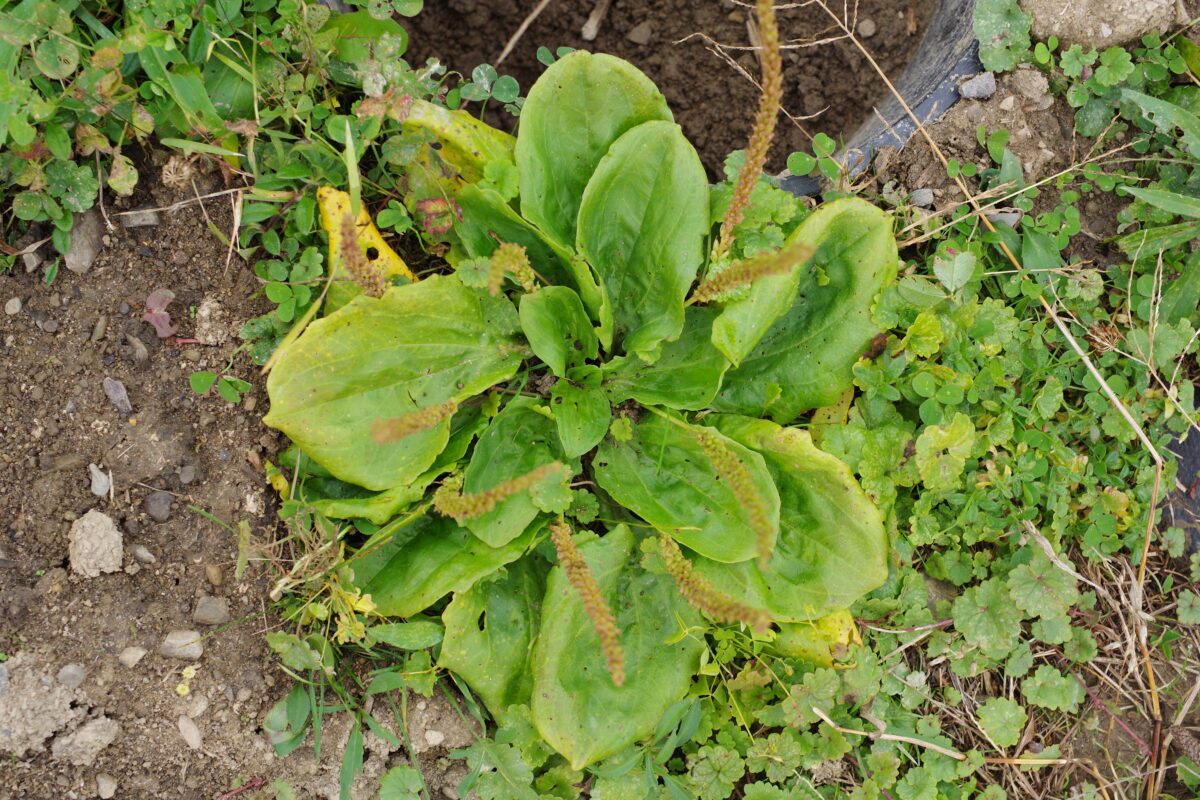
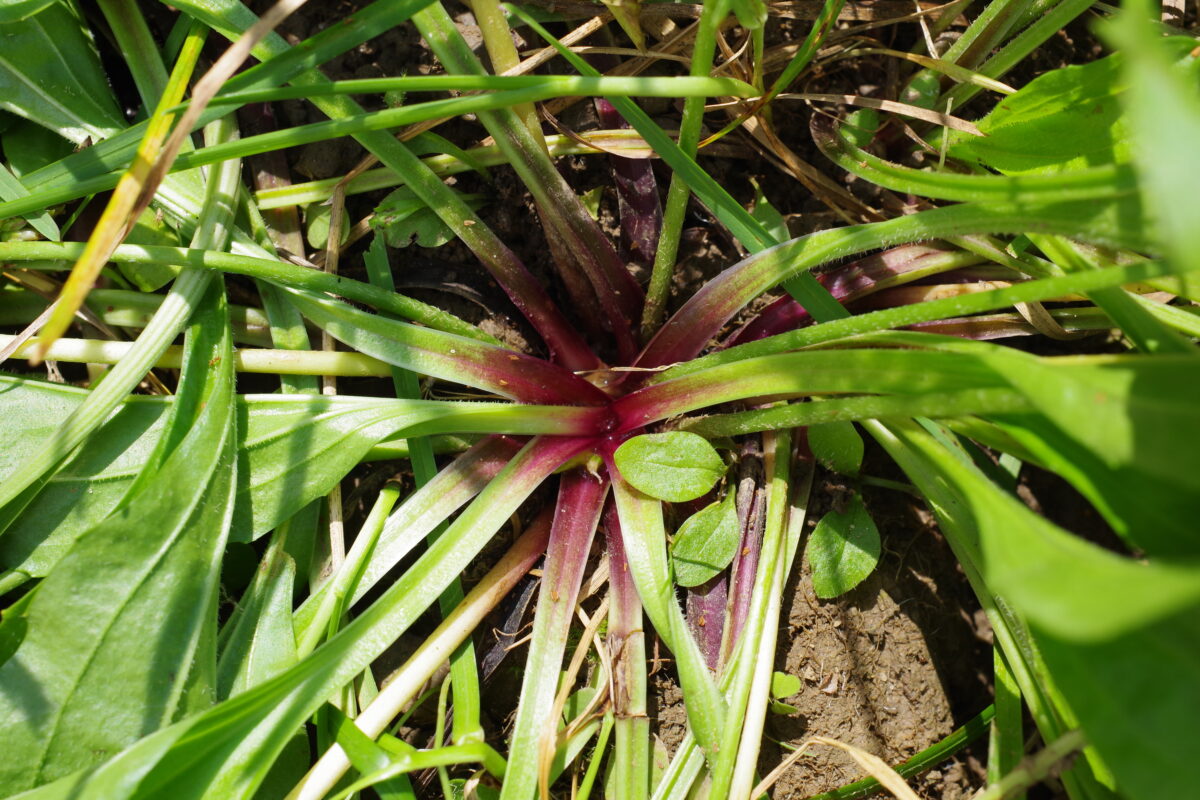
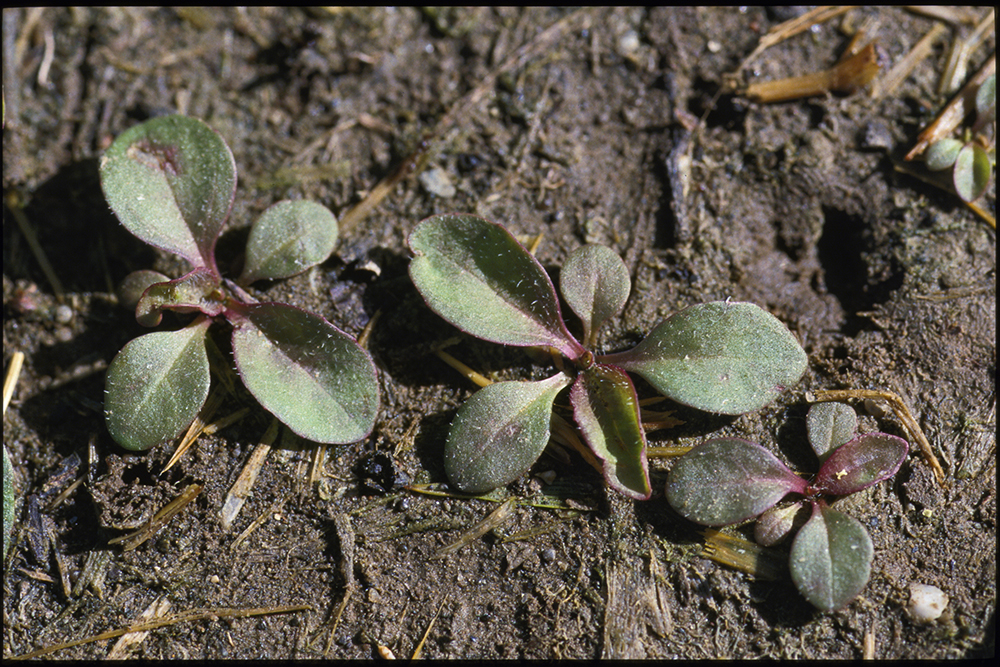
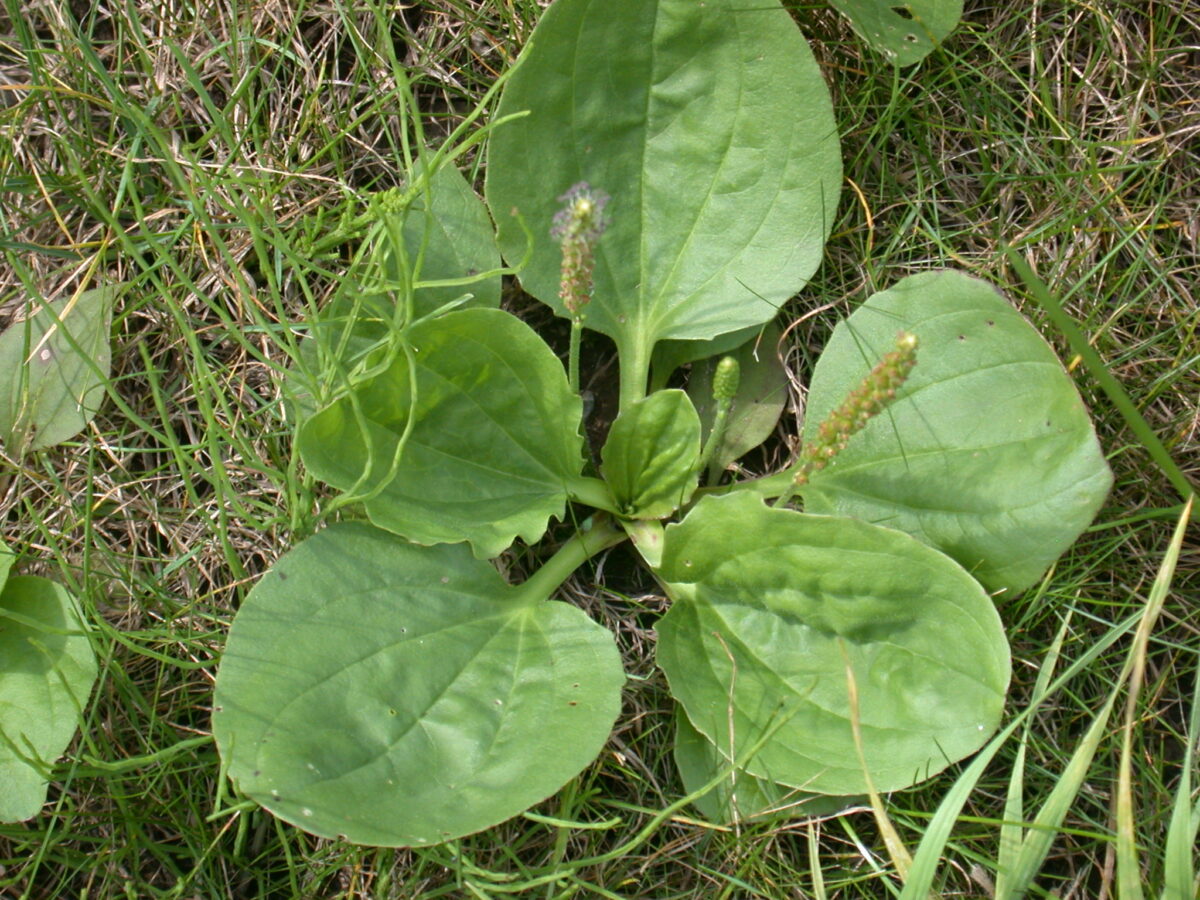
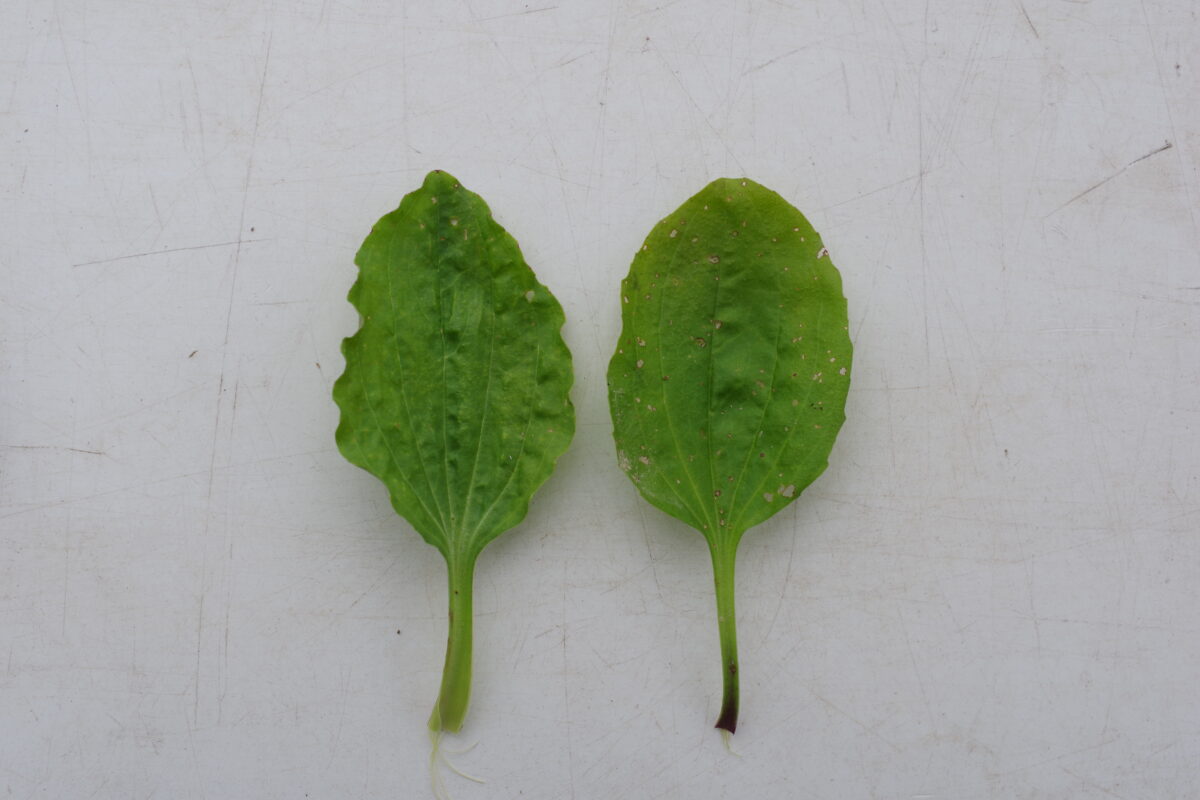
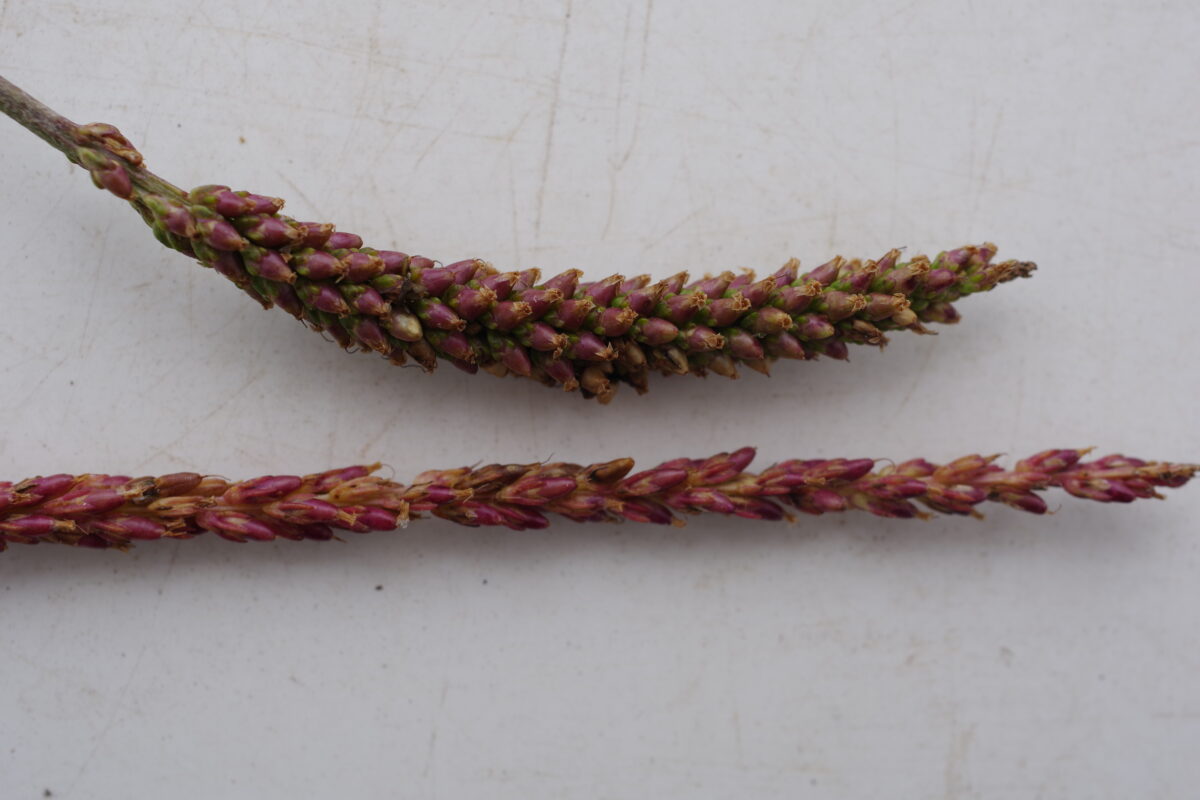
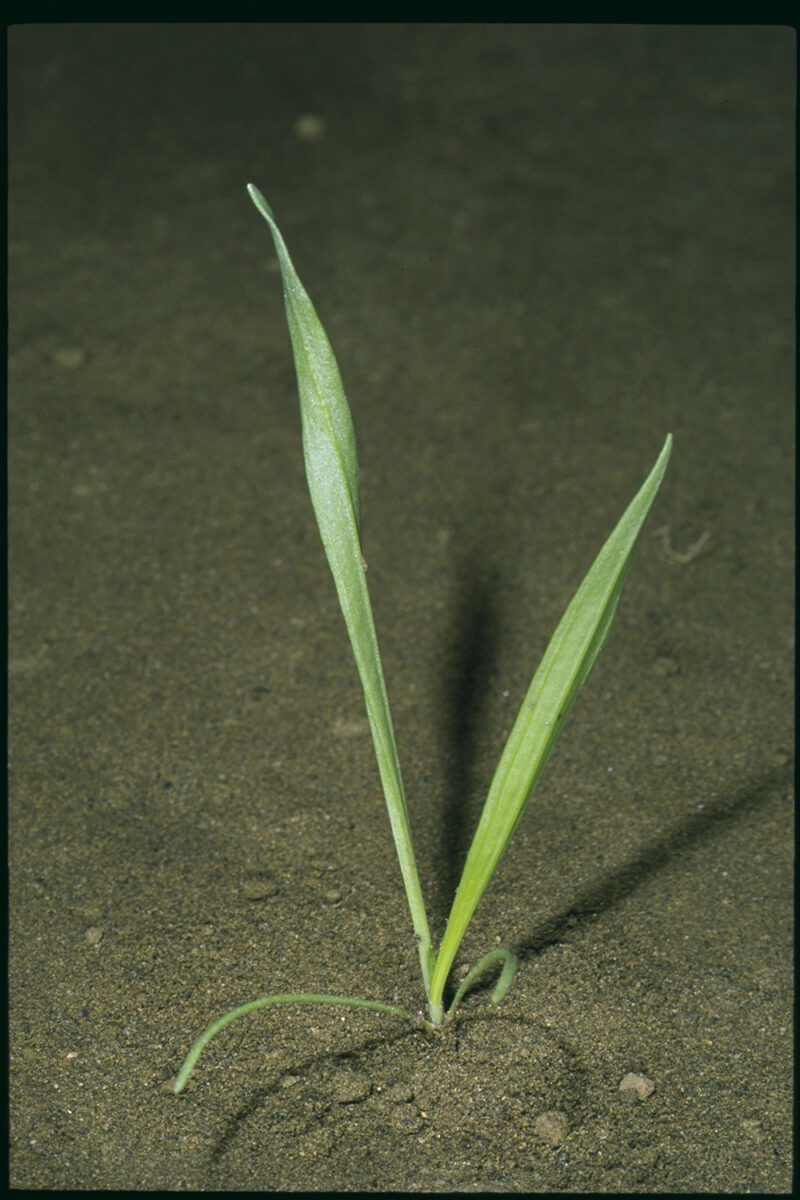
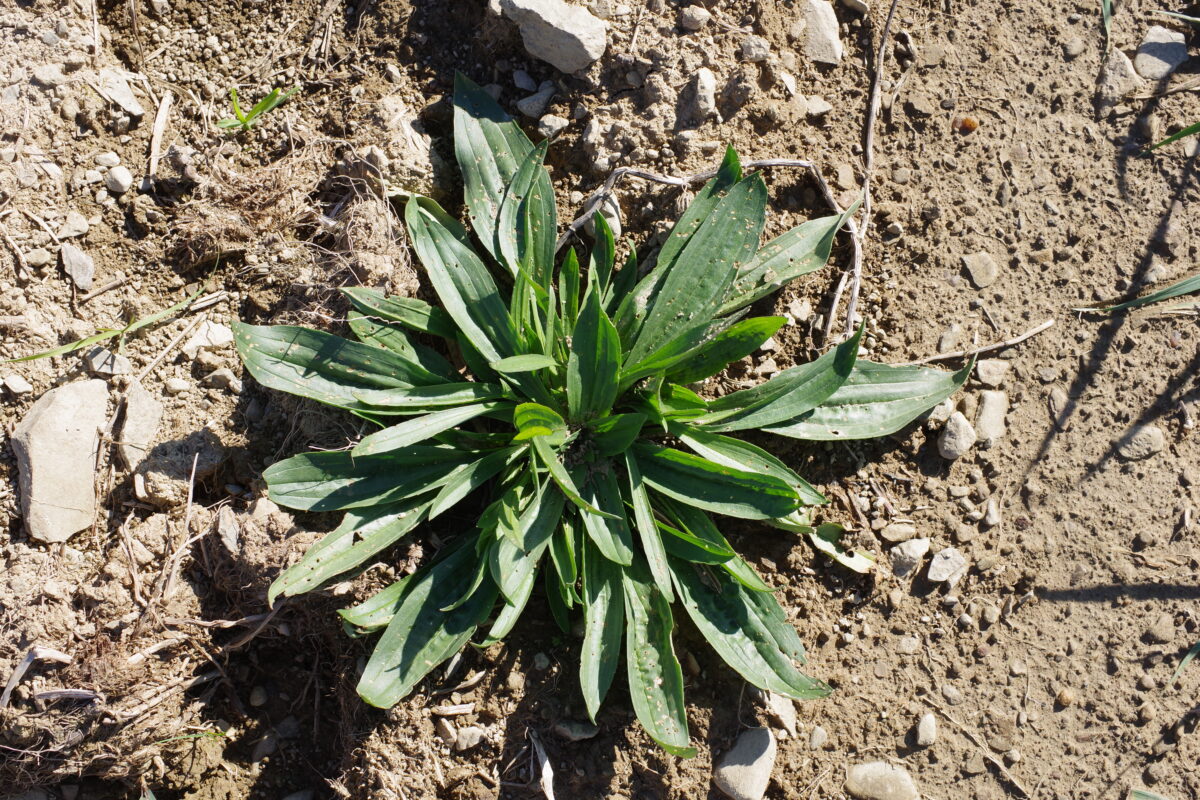
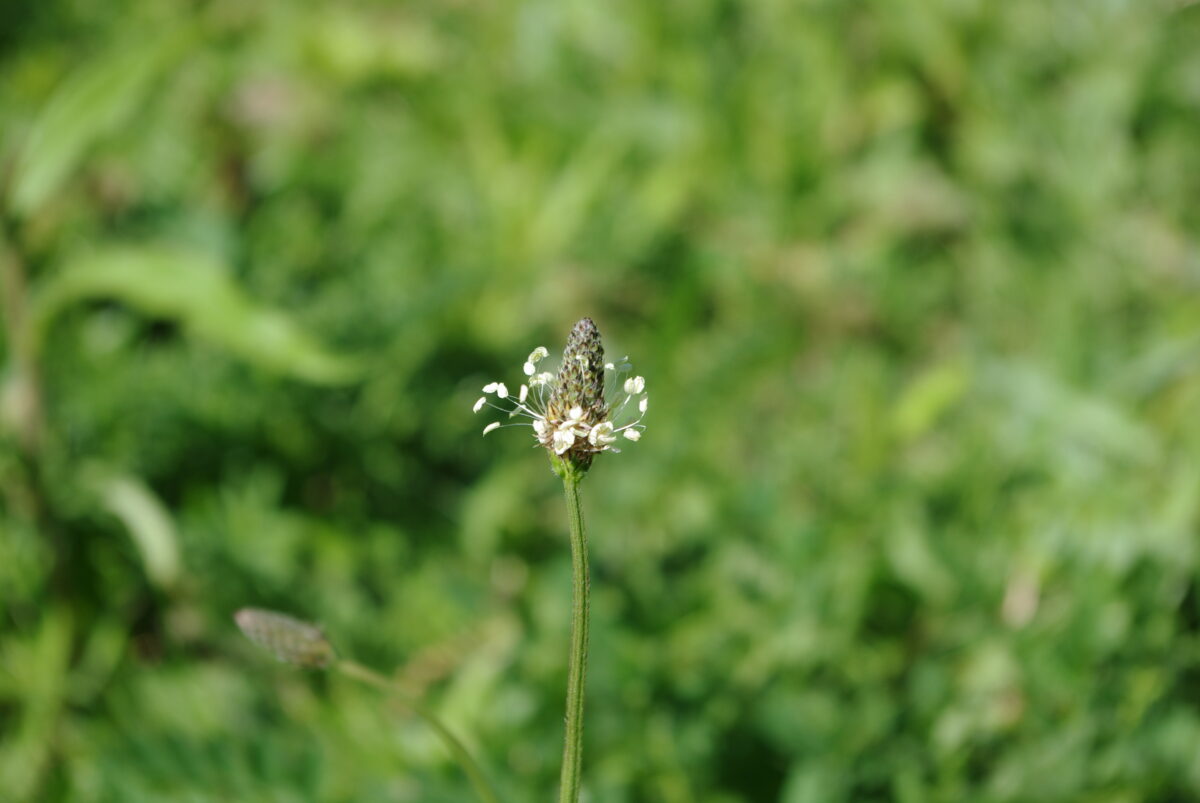
Blackseed plantain, Plantago rugelii Dcne.
Broadleaf plantain, Plantago major L.
Buckhorn plantain, Plantago lanceolata L.
Identification of Plantains
Family: Plantain family, Plantaginaceae
Habit: Perennial herbs with a basal rosette and a leafless flowering stalk
Description: Seedlings form alternate-leaved rosettes. True leaves have three to five prominent, parallel veins.
- Blackseed plantain: Cotyledons are spatula shaped, three-veined and up to 0.4 inch long and 0.08 inch wide. Young leaves are long stalked, dull green, oval to egg shaped and sparsely hairy. Leaf stalks have upturned edges and are usually pale pink to purplish red at the base.
- Broadleaf plantain: Cotyledons are spatula shaped, 0.06–0.28 inch long by 0.02–0.04 inch wide and three-veined. Young leaves are long stalked, oval to egg shaped and sparsely hairy. Leaf stalks have upturned edges and are green or occasionally pinkish at the base.
- Buckhorn plantain: Cotyledons are grass-like, 0.67–1.4 inch long by 0.04–0.06 inch wide, hairless, without a stalk and tapered at the base. The first true leaves are long, narrow and hairy along the margins; later leaves are sparsely hairy, with denser hairs at the base.
Mature plants form a rosette. Roots are fibrous with a short taproot.
- Blackseed plantain: Leaves are 0.8–8.7 inches long by 0.5–5.6 inches wide, oval to egg shaped, pale green, hairless and tapered at the tip. The leaves have five to nine veins. Leaf stalks are generally as long as the leaves and are usually pink to purplish red at the base. Leaf edges are wavy and smooth to occasionally toothed.
- Broadleaf plantain: Leaves are 0.8–8 inches long by 0.4–4 inches wide, oval to egg shaped, pale to dull green, leathery and sparsely hairy. The leaves have three to seven veins. Leaf stalks are generally as long as the leaves and are green or occasionally pink at the base. Leaf edges are wavy and smooth to occasionally toothed.
- Buckhorn plantain: Leaves are lanceolate, 3.1–12 inches long by 0.4–1.6 inch wide and have three to seven veins. The leaves have silky, white to brownish hairs at the leaf base and are otherwise hairless to sparsely hairy. Leaf stalks are short and inconspicuous or absent. Leaf edges are generally smooth but may have scattered, small teeth.
Inflorescences, produced at the end of upright and leafless stalks, are spikes of clustered, inconspicuous flowers.
- Blackseed plantain: Plants produce from one to nine flower stalks that can reach up to 20 inches tall. Flower spikes are cylindrical, up to 12 inches long and 0.23 inch wide, and are composed of up to 300 or more flowers. The flowers are pale green to whitish and 0.08–0.12 inch wide. Flowers are replaced by cylindrical, 0.16–0.24 inch-long capsules that split below the middle to release four to nine dark brown, glossy, 0.06–0.08 inch-long seeds. The seed surface is smooth.
- Broadleaf plantain: Plants produce from one to 30 flower stalks that can reach up to 20 inches tall. The cylindrical flower spikes are up to 10 inches long and 0.24 inch wide. Each spike is composed of up to 400 or more pale green to whitish, 0.08–0.11 inch-wide flowers. Seeds are produced in oval, 0.16–0.2 inch-long capsules that turn from green to brown as they mature. Ripe capsules split horizontally at the middle to release six to 30, irregular, glossy, brown, 0.02–0.06 inch-long seeds. The seed surface has a fine, web-like pattern visible under magnification.
- Buckhorn plantain: Plants produce from one to 30 flower stalks, which are up to 18 inches tall. The flower spike is conical to cylindrical and 0.8–3.2 inches long by 0.16–0.24 inch wide. Individual flowers are 0.08–0.12 inch wide and brown to yellow-brown. The stamens protrude from the flowers on up to 0.16 inch-long stalks. Seeds are produced in brown, oval, 0.12–0.16 inch-long capsules. Each capsule contains one to two oblong, glossy, dark brown to black, 0.08 inch-long seeds.
Similar species: Hoary plantain (Plantago media L.) is hairier and has much shorter leaf stalks than broadleaf plantain or blackseed plantain; the leaves are hairier and wider than those of buckhorn plantain (0.6–4.3 inches). Bracted plantain (Plantago aristata Michx.) has narrow leaves similar to buckhorn plantain, however the leaves and flowering stalks of bracted plantain are much hairier than those of buckhorn plantain, and the flowering spikes have long (up to 0.8 inch), hairy bracts throughout. Paleseed plantain (Plantago virginica L.) leaves and stalks are densely covered in soft, wooly hairs unlike broadleaf, blackseed or buckhorn plantain.
Management of Plantains
These species are primarily weeds of perennial forages, pastures and lawns. Generally, broadleaf plantain inhabits more highly disturbed habitats, has a shorter lifespan, earlier flowering, produces more and smaller seeds, and functions more like an annual plant than the other species. Blackseed and buckhorn plantain inhabit less disturbed sites, have a longer lifespan and lower investment in seed production, and behave more as perennials. Buckhorn plantain thrives in hay meadows and is particularly common in those with red clover. Except in seed production fields, this is scarcely a problem since the species is sufficiently productive and nutritious to have warranted development as a forage crop, with several commercially available named varieties. Buckhorn plantain is less common in pastures, but it is a useful component of a mixed species pasture because it continues to produce during hot, dry periods when productivity of C3 grasses and legumes declines. Broadleaf and blackseed plantain thrive in overgrazed pastures but tend to be out-competed in vigorous hay meadows. Using an intensive rotational grazing system helps suppress broadleaf and blackseed plantain in pastures by shading the plants during the growth phase of the forage and forcing a more upright growth form that is easier for livestock to eat. Fertility and good soil aeration will help favor forage grasses and legumes relative to plantains. Sowing uncontaminated forage seed is critical for preventing outbreaks of all three species.
Although broadleaf and blackseed plantain are commonly found in grain and vegetable crops, they rarely compete significantly with crops due to their relatively slow development and prostrate growth habit. Dense populations usually indicate soil problems. Shallowly moldboard plow with complete inversion (skim plow) to bury large plants, but then adopt a reduced tillage regimen with cover crops to improve soil structure. Avoid rotary tillage. Use a tine weeder to regularly harrow out seedlings and rotate into crops that allow hilling up to cover seedlings in the row.
Ecology of Plantains
Origin and distribution: Blackseed plantain is native to the eastern half of the United States and southern Canada. Broadleaf and buckhorn plantain are natives of Europe that have been spread widely throughout the world, including isolated oceanic islands. They tend to be uncommon in the lowland tropics. They occur throughout the United States. In Canada, broadleaf plantain occurs northward to above the Arctic Circle, whereas buckhorn plantain occurs primarily in southeastern and southwestern Canada.
Seed weight: Mean population seed weights for blackseed plantain range from 0.35–0.7 mg. Mean population seed weights for broadleaf plantain range from 0.06–0.34 mg. Buckhorn mean seed weights range from 0.8–2.9 mg.
Dormancy and germination: Usually, a substantial proportion of fresh seeds of all three species are capable of immediate germination, though most seeds of broadleaf plantain produced in midsummer are dormant. Dormant seeds lose dormancy over the winter. Optimal temperature for germination of broadleaf plantain is 77–86°F; however, exposure too cold for several weeks lowers the minimum temperature required for an optimum response to 59°F. Buckhorn plantain had a similar response to temperature, but the minimum temperatures giving maximum germination were lower than those for broadleaf plantain. Nitrate stimulates germination of broadleaf and buckhorn plantain, and fluctuating temperatures promote germination of broadleaf plantain. Light promotes germination of all three species, but there can be complex interactions between light, temperature and nitrate. For example, dormancy of broadleaf and blackseed plantain was relieved by prechilling at 41°F for two weeks in combination with light, nitrate and alternating day/night temperatures of 86/68°F, whereas either light or nitrate was sufficient for germination of buckhorn plantain. Cold stratification and fluctuating temperature partially relieved the light requirement of broadleaf plantain. Germination of cold-stratified buckhorn plantain seeds was minimally increased by light or by light that passed through a leaf canopy.
Seed longevity: In an experiment that compared all three species, blackseed, broadleaf and buckhorn plantain survived 21, 30 and 16 years, respectively. Broadleaf plantain can remain viable in soil for 50–60 years. In one experiment, 68–87% of seeds of broadleaf plantain were viable after three years, and in other experiments, seeds maintained up to 10% viability after 40 years of burial in undisturbed soil. Buckhorn plantain seeds had 34–76% viability after three to four years and 8% viability after 10 years of burial. In various experiments in cultivated soil, broadleaf plantain seeds declined by 33–43% per year and buckhorn plantain seeds declined by 60–67% per year.
Season of emergence: Emergence from mature plants occurs in mid-spring, whereas emergence of seedlings occurs throughout the growing season, with a peak in late spring. On average, buckhorn emerged earlier than broadleaf plantain, probably because it has a lower temperature minimum for germination.
Emergence depth: Broadleaf plantain seedlings emerge only from the top 0.2 inch of soil. Buckhorn plantain emerges best from the top 0.8 inch of soil, with declining emergence to 2.4 inches. No seedlings emerge from 3.1 inches. Information on emergence depth is unavailable for blackseed plantain, but the small seeds of this species probably restrict emergence to the top 1 inch or less of the soil.
Photosynthetic pathway: C3
Sensitivity to frost: All three species are highly frost tolerant. Even in northern areas they often overwinter as rosettes of small leaves, though in open sites, leaves may be lost for the winter.
Drought tolerance: Buckhorn plantain is relatively drought tolerant and commonly occurs in droughty sites like the gravel of railroad embankments. Blackseed plantain is probably the least drought tolerant of the three species, with broadleaf plantain having intermediate drought tolerance. Mature plants of all three species have dense, deep root systems to 32 inches, which allow them to extract soil moisture during drought.
Mycorrhiza: Broadleaf and buckhorn plantain are mycorrhizal. All three plantain species were highly colonized in prairie habitats.
Response to fertility: Broadleaf responds more to increased nutrient levels than does blackseed plantain. But, increased nutrient levels delayed flowering of blackseed more than that of broadleaf plantain. Broadleaf plantain commonly occurs in cracks in concrete pavement, indicating that it tolerates very high pH (higher than 8) and low N and P. Broadleaf and buckhorn plantain were associated with fields with a pH of 6.5–7.8. Buckhorn plantain growth, reproductive output and seed weight were increased by increased nutrient availability. Buckhorn plantain responds to P but tolerates low levels of K. Buckhorn is more responsive to P than is broadleaf plantain. It prefers neutral to calcareous soils and is excluded from soil with a pH below 4.5. Unlike most non-legumes, buckhorn plantain has bacteria associated with its roots that fix substantial amounts of N.
Soil physical requirements: All three species regularly occur on a wide range of soil types from clay to sand. Buckhorn plantain is most common on dry soils. All three species are highly tolerant of soil compaction. Broadleaf plantain tolerates long periods of waterlogging. The presence of buckhorn plantain on seashores and the abundance of both buckhorn and broadleaf plantain along roadways receiving de-icing salts indicate that both species are salt tolerant.
Response to shade: All three species tolerate some shading, but blackseed and buckhorn appear to be more shade tolerant than broadleaf plantain. Buckhorn plantain seedlings are able to grow moderately well at light levels similar to those in a dense grassland, whereas broadleaf and blackseed require periodic mowing or grazing of taller vegetation. In shaded conditions buckhorn plantain leaves become longer and more vertical, and seed weight is increased.
Sensitivity to disturbance: Since the stem lies just below ground and the leaves are fibrous and resistant to tearing, these species are highly tolerant of traffic by people, animals and tires. Even the flowering stalks are flexible and difficult to crush. Because of its upright habit, buckhorn plantain is somewhat less tolerant of traffic than the other two species. None of the species can grow back out of the soil when completely buried by tillage, but the extensive fibrous root systems of larger plants tend to help them survive and reroot after cultivation. Consequently, shallow cultivation or hoeing that cuts the plant off just below the stem will be more effective than deeper cultivation that leaves more roots attached. Removal of buckhorn plantain cotyledons results in reduced early plant growth but no adverse effect on reproduction.
Time from emergence to reproduction: Without competition, broadleaf plantain can flower within six to 10 weeks of emergence. Blackseed plantain is slower. Development of both species is slowed by competition and cool temperatures, and consequently, many plants remain vegetative their first season when shaded by taller plants. Older plants begin flowering in mid-June and continue flowering through fall. Seeds develop two to three weeks after the flowers open. Time to flowering in buckhorn plantain varies greatly with conditions and populations. A 13-hour day length is required to initiate flowering in broadleaf and blackseed, whereas a 16-hour day length is required to induce flowering in buckhorn plantain.
Pollination: These species are wind pollinated. Some plants of buckhorn plantain produce only flowers of one sex, thereby ensuring cross pollination. Other plants of buckhorn, and all plants of broadleaf and blackseed plantain, can self-pollinate.
Reproduction: In a pasture in Ontario, broadleaf and blackseed plantain plants produced an average of 565 and 662 seeds per year. In favorable conditions, blackseed plantain can produce 5,000 seeds per plant per year, and broadleaf plantain can produce 15,000–36,000 seeds per plant per year, depending on location. Seeds of broadleaf and blackseed plantain often remain in the capsules through the winter. In a dry grassland in Ontario, buckhorn plantain plants produced an average of 127 seeds in one season, whereas in a fertile agricultural field nearby, plants produced more than 10,000 seeds. In Great Britain, buckhorn produced 4,000 seeds per plant in a year. All three species occasionally produce side shoots that eventually become independent plants, but this is common only in buckhorn plantain. In all three species, the daughter plants usually remain closely clumped with the parent.
Dispersal: All three species spread in forage seed, and buckhorn plantain in particular is a notorious contaminant of red clover seed. Seeds of all three species also spread in soil clinging to tires and machinery. Buckhorn and broadleaf plantain are spread in livestock manure, and blackseed plantain may be as well. They also spread in bird and deer droppings. Seeds of these species contain a mucilage that makes them sticky when wet and may facilitate dispersal on fur and feathers.
Common natural enemies: Many fungi and insects attack plantains, but substantial damage by natural enemies is rare.
Palatability: All three species are palatable to livestock. Domesticated cultivars of buckhorn plantain have been developed. Young leaves of broadleaf plantain have been cooked like spinach and dried leaves brewed as tea.
Note: All three species produce large amounts of windborne pollen that can cause hay fever in sensitive individuals.
Summary Table of Plantain Characteristics
| Plantain, blackseed Plantain, broadleaf Plantain, buckhorn | ||||||||
|---|---|---|---|---|---|---|---|---|
| Growth habit | Perennial overwinter organ | Emergence period from perennial organs | Optimum emergence depth (inches) from perennial organs | Time/stage of lowest reserves | Photosynthesis type | Frost tolerance | Drought tolerance | Mycorrhiza |
| rosette | basal stem | mid-spring | na | – | C3 | high | high | yes |
| Fertility response | Importance of seeds to weediness | Seed weight (mg) | Dormancy of shed seeds | Factors breaking dormancy | Optimum temperarature range (F) for seed germination | Seedling emergence period | Emergence to flowering (weeks) | |
| low | high | 0.35–0.7 0.06–0.34 0.8–2.9 | variable | cms, li, at, ni | 59–86 | late spring to summer | 6–10 | |
Table Key
Perennial overwinter organ: Principal plant organ that survives winter and from which growth resumes in subsequent years.
Emergence period from perennial organs: Time of year when most emergence occurs from perennial overwintering organs in the typical regions of occurrence for each weed. Some emergence may occur outside of this range.
Optimum emergence depth from perennial organs: Soil depths (in inches below the soil surface) from which most shoots emerge from perennial organs. Lower rates of emergence usually will occur at depths above or below this range.
Time/stage of lowest reserves: Time of year and/or weed growth stage at which carbohydrate reserves are lowest. This usually corresponds to the time when the weed is most susceptible to weed management operations.
Frost tolerance: Relative tolerance of aboveground shoots to freezing temperatures (high, moderate, low).
Drought tolerance: Relative tolerance of aboveground plants to drought (high, moderate, low).
Importance of seeds to weediness: The relative importance of seeds to dispersal, genetic diversity and survival of the species as a weed in agricultural environments (high, moderate, low). Emergence to flowering: Length of time (weeks) after emergence from perennial organs to the beginning of flowering in the typical regions of occurrence. Note that this refers to established perennial plants, recognizing that some species may not flower in their initial year of establishment.
Further Reading
Cavers, P.B., I.J. Bassett and C.W. Crompton. 1980. The biology of Canadian weeds. 47. Plantago lanceolata L. Canadian Journal of Plant Science 60: 1269–1282.
Hawthorn, W.R. 1974. The biology of Canadian weeds. 4. Plantago major and P. rugelii. Canadian Journal of Plant Science 54: 383–396.
Hawthorn, W.R. and P.B. Cavers. 1976. Population dynamics of the perennial herbs Plantago major L. and P. rugelii Decne. Journal of Ecology 64: 511–527.
Sagar, G.R. and J.L. Harper. 1964. Biological Flora of the British Isles. Plantago major L., P. media L. and P. lanceolata L. Journal of Ecology 52: 189–221.

